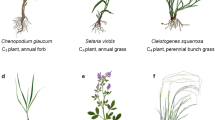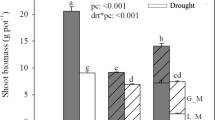Summary
In a 2-year experiment, the evergreen shrubsErica tetralix andCalluna vulgaris (dominant on nutrient-poor heathland soils) and the perennial deciduous grassMolinia caerulea (dominant on nutrient-rich heathland soils) were grown in replacement series in a factorial combination of four competition types (no competition, only aboveground competition, only belowground competition, full competition) and two levels of nutrient supply (no nutrients and 10 g N+2 g P+10 g K m−2 yr−1). Both in the unfertilized and in the fertilized treatmentsMolinia allocated about twice as much biomass to its root system than didErica andCalluna. In all three species the relative amount of biomass allocated to the roots was lower at high than at low nutrient supply. The relative decrease was larger forMolinia than forErica andCalluna. In the fertilized monocultures biomass of all three species exceeded that in the unfertilized series.Molinia showed the greatest biomass increase. In the unfertilized series no effects of interspecific competition on the biomass of each species were observed in either of the competition treatments. In the fertilized mixtures where only belowground competition was possibleMolinia increased its biomass at the expense of bothErica andCalluna. When only aboveground competition was possible no effects of interspecific competition on the biomass of the competing species were observed. However, in contrast with the evergreens,Molinia responded by positioning its leaf layers relatively higher in the canopy. The effects of full competition were similar to those of only belowground competition, so in the fertilized series belowground competition determined the outcome of competition. The high competitive ability ofMolinia at high nutrient supply can be attributed to the combination of (1) a high potential productivity, (2) a high percentage biomass allocation to the roots, (3) an extensive root system exploiting a large soil volume, and (4) plasticity in the spatial arrangement of leaf layers over its tall canopy. In the species under study the allocation patterns entailed no apparent trade-off between the abilities to compete for above- and belowground resources. This study suggests that this trade-off can be overcome by: (1) plasticity in the spatial arrangement of leaf layers and roots, and (2) compensatory phenotypic and species-specific differences in specific leaf area and specific root length.
Similar content being viewed by others
References
Aerts R (1990) Nutrient use efficiency in evergreen and deciduous species from heathlands. Oecologia 84:391–397
Aerts R, Berendse F, Klerk NM, Bakker C (1989) Root production and root turnover in two dominant species of wet heathlands. Oecologia 81:374–378
Aerts R, Berendse F, De Caluwe H, Schmitz M (1990) Competition in heathland along an experimental gradient of nutrient availability. Oikos 57:310–318
Baan Hofman T, Ennik GC (1980) Investigation into plant characters affecting the competitive ability of perennial ryegrass (Lolium perenne L.). Neth J Agric Sci 28:97–109
Baan Hofman T, Ennik GC (1982) The effect of root mass of perennial ryegrass (Lolium perenne L.) on the competitive ability with respect to couchgrass (Elytrigia repens (L.) Desv). Neth J Agric Sci 30:275–283
Barnes PW, Jordan PW, Gold WG, Flint SD, Caldwell MM (1988) Competition, morphology and canopy structure in wheat (Triticum aestivum L.) and wild oat (Avena fatua L.) exposed to enhanced ultraviolet-B radiation. Funct Ecol 2:319–330
Barnes PW, Beyschlag W, Ryel R, Flint SD, Caldwell MM (1990) Plant competition for light analyzed with a multispecies canopy model. III. Influence of canopy structure in mixtures and monocultures of wheat and wild oat. Oecologia 82:560–566
Berendse F (1990) Organic matter accumulation and nitrogen mineralization during secondary succession in heathland ecosystems. J Ecol 78:413–427
Berendse F, Elberse WT (1989) Competition and nutrient losses from the plant. In: Lambers H et al. (eds), Causes and consequences of variation in growth rate and productivity of higher plants, SPB Academic Publishing, The Hague, pp 269–284
Berendse F, Oudhof H, Bol J (1987) A comparative study on nutrient cycling in wet heathland ecosystems. I Litter production and nutrient losses from the plant. Oecologia 74:174–184
Boot RGA (1989) The significance of size and morphology of root systems for nutrient acquisition and competition. In: Lambers H et al. (eds), Causes and consequences of variation in growth rate and productivity of higher plants, SPB Academic Publishing, The Hague, pp 299–311
Boot RGA, Den Dubbelden K (1990) Effects of nitrogen supply on growth, allocation and gas exchange characteristics of two perennial grasses from inland dunes. Oecologia 85:115–121
Boot RGA, Mensink M (1990) Size and morphology of root systems of perennial grasses from contrasting habitats as affected by nitrogen supply. Plant and Soil 129:291–299
Brouwer R (1962a) Distribution of dry matter in the plant. Neth J Agric Sci 10:361–376
Brouwer R (1962b) Nutritive influences on the distribution of dry matter in the plant. Neth J Agric Sci 10:399–408
Caldwell MM (1987) Competition between root systems in natural communities. In: Gregory RJ, Lake JV, Rose DA (eds) Root development and function. Society for Experimental Botany, Seminar Series 30, Cambridge University Press, pp 167–185
Caldwell MM, Richards JH (1986) Competing roots systems: morphology and models of absorption. In: Givnish TJ (ed), On the economy of plant form and function. Cambridge University Press, Cambridge, pp 251–273
Chapin FS (1980) The mineral nutrition of wild plants. Ann Rev Ecol Syst 11:233–260
Conolly J, Wayne P, Murray R (1990) Time course of plant-plant interactions in experimental mixtures of annuals: density, frequency, and nutrient effects. Oecologia 82:513–526
Crick JC, Grime JP (1987) Morphological plasticity and mineral nutrient capture in two herbaceous species of contrasted ecology. New Phytol 107:403–414
Eissenstat DM, Caldwell MM (1988) Competitive ability is linked to rates of water extraction: a field study of two arid tussock grasses. Oecologia 75:1–7
Eissenstat DM, Caldwell MM (1989) Invasive root growth into disturbed soil of two tussock grasses that differ in competitive effectiveness. Funct Ecol 3:345–353
Ennik GC, Baan Hofman T (1983) Variation in the root mass of ryegrass types and its ecological consequences. Neth J Agric Sci 31:325–334
Gleeson SK, Tilman D (1990) Allocation and the transient dynamics of succession on poor soils. Ecology 71:1144–1155
Grime JP (1979) Plant strategies and vegetation processes. Wiley, Chichester
Grime JP (1988) Limiting factors for modellers. Nature 336:630
Grime JP, Hodgson JG (1987) Botanical contributions to contemporary ecological theory. In: Rorison IH, Grime JP, Hunt R, Hendry GAF, Lewis DH (eds) Frontiers of comparative plant ecology, Academic Press, London. New Phytol (Supplement) 106:283–296
Grime JP, Crick JC, Rincon JE (1986) The ecological significance of plasticity. In: Jennings DH, Trewavas AJ (eds) Plasticity in plants, Cambridge University Press, Cambridge, pp 5–29
Grime JP, Mackey JML, Hillier SH, Read DJ (1987) Floristic diversity in a model system using experimental microcosms. Nature 328:420–422
Grime JP, Campbell BD, Mackey JML, Crick JC (1990) Root plasticity, nitrogen capture and competitive ability. In: Atkinson D (ed), Plant root systems. Their effect on ecosystem composition and structure. Proceedings BES Symposium, Aberdeen, September 1988 (in press)
Heil GW, Bruggink M (1987) Competition for nutrients betweenCalluna vulgaris (L.) Hull andMolinia caerulea (L.) Moench. Oecologia 73:105–108
Karlsson PS (1985) Effects of water and mineral nutrient supply on a deciduous and an evergreen dwarfshrub:Vaccinium uliginosum L. andV. vitis-idaea L. Holarctic Ecol 8:1–8
Konings H, Koot E, Tijman-de Wolf A (1989) Growth characteristics, nutrient allocation and photosynthesis ofCarex species from floating fens. Oecologia 80:111–121
Lambers H, Dijkstra P (1987) A physiological analysis of genotypic variation in relative growth rate: Can growth rate confer ecological advantage? In: Van Andel J et al. (eds), Disturbance in Grasslands. Junk Publishers, Dordrecht, pp 237–252
Mahmoud A, Grime JP (1976) An analysis of competitive ability in three perennial grasses. New Phytol 77:431–435
Mitchley J (1988) Control of relative abundance of perennials in chalk grassland in Southern England. II. Vertical canopy structure. J Ecol 76:341–350
Monsi M, Saeki T (1953) Über den Lichtfaktor in den Pflanzengesellschaften und seine Bedeutung für die Stoffproduktion. Jap J Bot 14:22–52
Olff H, Van Andel J, Bakker JP (1990) Biomass and shoot/root allocation of five species from a grassland succession series at different combinations of light and nutrient supply. Funct Ecol 4:193–200
Pegtel BM (1976) On the ecology of two varieties ofSonchus arvensis L. PhD Thesis, University of Groningen
Poorter H, Remkes C (1990) Leaf area ratio and net assimilation rate of 24 wild species differing in relative growth rate. Oecologia 83:553–559
Robinson D, Rorison IH (1988) Plasticity in grass species in relation to nitrogen supply. Funct Ecol 2:249–257
Roush ML, Radosevich SR (1985) Relationships between growth and competitiveness of four annual weeds. J Appl Ecol 22: 895–905
SAS Institute Inc (1985) SAS/STAT Guide for personal computers, Version 6 Edition. Cary, N.C.: SAS Institute Inc
Spitters CJT, Aerts R (1983) Simulation of competition for light and water in crop-weed associations. Aspects of Applied Biology 4:467–483
Thompson K (1987) The resource ratio hypothesis and the meaning of competition. Funct Ecol 1:297–303
Thompson K, Grime JP (1988) Competition reconsidered — a reply to Tilman. Funct Ecol 2:114–116
Tilman D (1985) The resource-ratio hypothesis of plant succession. Am Nat 125:827–852
Tilman D (1987) On the meaning of competition and the mechanisms of competitive superiority. Funct Ecol 1:304–315
Tilman D (1988) Plant strategies and the dynamics and structure of plant communities. Princeton University Press, Princeton, New Jersey
Tilman D, Cowan ML (1989) Growth of old field herbs on a nitrogen gradient. Funct Ecol 3:425–438
Wilson JB (1988a) The effect of initial advantage on the course of plant competition. Oikos 51:19–24
Wilson JB (1988b) Shoot competition and root competition. J Appl Ecol 25:279–296
Author information
Authors and Affiliations
Rights and permissions
About this article
Cite this article
Aerts, R., Boot, R.G.A. & van der Aart, P.J.M. The relation between above- and belowground biomass allocation patterns and competitive ability. Oecologia 87, 551–559 (1991). https://doi.org/10.1007/BF00320419
Received:
Accepted:
Issue Date:
DOI: https://doi.org/10.1007/BF00320419




